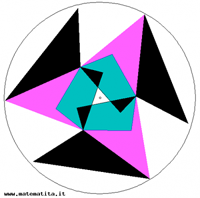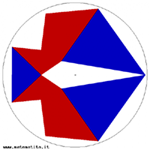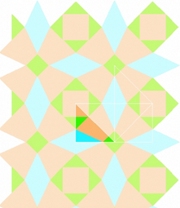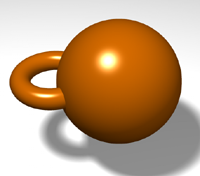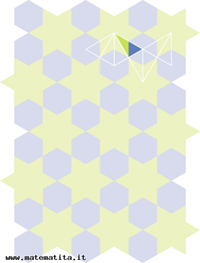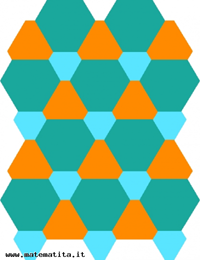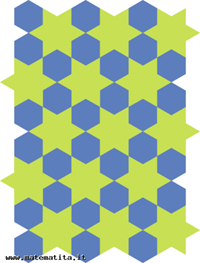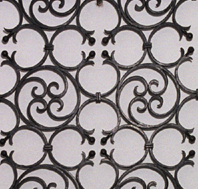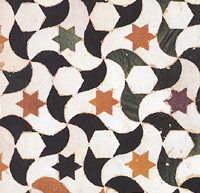The Conway symbol
Posted by admin on 18 Mar 2011 in the Conway symbol
The signature introduced by Conway to denote symmetry groups describes precisely their quotients, that is the orbifolds which act as stamps. This signature is a string containing numbers and symbols (a dot o, a star *, a cross ×; in the case of friezes, we have also the symbol ∞). Let’s see what these numbers and symbols mean.
- A number appearing before possible stars denotes in the stamp the vertex of a cone (we call it conical point) and the number gives the information about the opening of this cone (more precisely, the number k corresponds to an opening of 2π/k); on a plane drawing with that symmetry group, the number k indicates there exist symmetry centers of order k (that is: points P such that a rotation with center P and angle 2π/k sends the drawing to itself); moreover, the fact that in the string the number k comes before any star means that the corresponding rotations center in the drawing does NOT lie on a symmetry axis (and we call them gyration points); for example this image corresponds to a 3 in the string, while the centers of the black squares in this drawing give rise to a 4 in the Conway signature (because a 90° rotation with center one of these points leaves the drawing unaltered and the symmetry axis of the drawing do not contain these points).
- A star * indicates the presence in the quotient of a boundary line; on the plane drawing with that symmetry group, a star means there exist symmetry axis in the drawing (that is: lines such that the reflection with respect to that line sends the drawing to itself). It should not appear strange that a symmetry axis in the drawing gives rise to a boundary line in the quotient: let’s imagine a drawing like this one, with a very simple symmetry group containing, besides the identity, only the reflection with respect to a line; in order to construct the quotient, we simply have to “fold” the plane in half, following this line, thus getting a boundary line just corresponding to the symmetry axis. So, this drawing has in its Conway signature ** two stars; and the stars are two because there are symmetry axis of two different kinds: one passing by the paws of the birds, and a different one passing by their wings; and, also when we imagine the drawing repeating at infinity, all other symmetry axes may be sent in one of these two by a translation fixing the whole drawing.
- A number following a star * represents on the orbifold a corner point in the boundary line (and the number k means it is a corner with angle π/k); on a plane drawing with that symmetry group, a star followed by a number k indicates there are two symmetry axes meeting in a point P and making in this point an angle π/k (which means also that point P is a symmetry center of order k in the drawing). In the example of the mirror box corresponding to this drawing, the Conway signature is *442. Indeed, the quotient is just the triangle corresponding to the mirror box, and this has just one border line, with three angles measuring respectively π/4, π/4 and π/2. We can “read” on the drawing the fact we have two symbols “4” in the signature and just one “2” observing that all rotation centers of order 2 are equivalent (meaning that we can find a symmetry of the drawing sending one of them into the other one), while the rotation centers of order 4 are of two different kind (the centers of the small squares and the centers of the big ones).
- A cross × corresponds in the orbifold to attaching a Moebius strip; on a plane drawing with that symmetry group, the cross indicates what is called by Conway a miracle, that is the presence of two images, mirror images one of the other, such that we can find a path in the plane going from one to the other and NOT crossing any symmetry axis of the drawing: like we can see for example with the sequence of footprints in a regular walking. A wallpaper pattern having a cross in its Conway signature is the one we can see in a herringbone pattern: the corresponding group has Conway signature 22×.
- A dot o corresponds in the orbifold to the attaching of a handle; on a plane drawing with that symmetry group, the dot indicates the presence of what is called by Conway a wonder-ring, that is a couple of paths connecting three images which are related by translations (fixing the whole drawing), and such that there are no other ways to relate these images (through rotations or other isometries fixing the whole drawing); this is what we see for example in this drawing; this is also the only possibility for a wallpaper pattern whose Conway signature contains a dot (and, in fact, its Conway signature is just a single dot o).
3/4, to be continued
